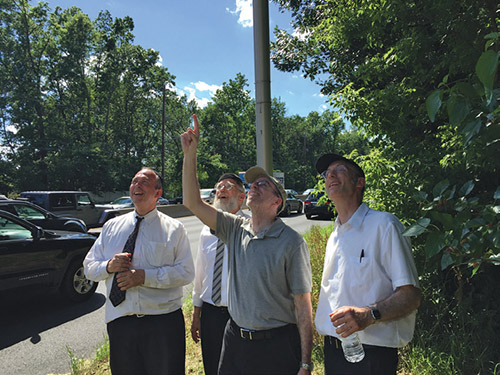
You might have seen Rabbis Neuberger, Sobolofsky, Taubes and Jachter walking throughout greater Teaneck last Tuesday and wondered why the rabbinical parade. The answer is that we were conducting our annual full walking review of the greater Teaneck eruv. Here are some frequently asked questions about the annual eruv walking inspection:
Question #1—Why is it necessary to inspect the eruv?
Many have the impression that it is sufficient to create the eruv and it should last forever. However, as applies with most things, regular inspection and maintenance is essential. Eruvin have been aptly compared to a moving target as its components can easily change at a moment’s notice, even absent a catastrophic event such as Hurricane Sandy.
Community Eruvin in North America rely for the most part on pre-existing structures such as utility poles and wires. These items are occasionally changed without notice by the power authorities. In fact, a number of years ago, eruv inspectors discovered one Friday that the utility company changed the configuration of its utility wires, eviscerating the Eruv’s southern boundary. The eruv team had to scramble to reconstruct the eruv in time for Shabbat.
Fences and even buildings sometimes are removed, and these structures must also be carefully monitored by the eruv team.
Question #2—Isn’t the eruv inspected weekly?
The greater Teaneck eruv is indeed inspected weekly by our very able inspector Rav Raphi Steinhart. Rav Raphi does a yeoman’s job inspecting the eruv. He notices any slight issue and makes sure that the eruv remains in the best shape possible. The weekly inspection, however, is conducted by car.
In addition, each year, the greater Teaneck eruv va’ad, consisting of the aforementioned rabbanim along with Rav Larry Rothwachs and Rav Ezra Wiener (as well as our very talented eruv administrator Rav Micha Shotkin), conducts a walking inspection of the eruv. As Rav Moshe Heinemann has observed, walking an eruv is the only possible way to conduct a thorough and meticulous review of the eruv.
The rabbinic team not only looks for problems overlooked while inspecting the eruv by car, but seeks ways to further enhance the quality of the eruv. This year we sought to further reduce the degree of change of direction tolerated in the eruv lines, reduce the space between lechis and ensure that a lechi is installed even at gaps less than 10 amot.
Question #3—The eruv is already kosher—why make it more kosher?
The Navi Zecharia (in a selection read on both Shabbat Chanukah and the Shabbat of Parshat Beha’alotecha) contrasts between beings that are omdim (stand still) and those that are mehalchim (those who walk, i.e., move and progress). Malachim (angels) stand still. Their spiritual level is fixed and never wavers. Human beings, on the other hand, are intended by Hashem to continuously improve and grow. The greater Teaneck eruv va’ad were certainly mehalchim during the eruv inspection, logging nearly 10 hours of walking during what was a rabbinic/halachic marathon.
Rav Hershel Schachter told me that every year the rabbanim of a community should make an effort to add hidurim (halachic enhancements) to its eruv. Indeed, it has been reported that each year when Rav Schachter conducts his yearly walking inspection of the Yeshiva University area eruv with rabbinical students, he seeks ways to enhance the halachic standards of that eruv.
Baalei mussar (leaders of the mussar/self-improvement movement) teach that one must grow in spirituality, for if one does not grow he will deteriorate. They point out that the Torah forbids creating steps on which to ascend the mizbei’ach. Instead, a ramp is used. While ascending a ramp, one must move forward or he will slide backward. In our attempt to scale the mountain of Hashem (mi ya’aleh b’har Hashem) we must assiduously strive to inch forward lest we scale backward.
This is no different than the ethic to which one must adhere in order to operate a successful business or institution. A culture of continuous improvement is not a luxury, as business leaders know very well, but rather a necessity. A communal eruv should be treated at least with the same respect and dignity as we accord to our businesses.
Question #4—Why so many rabbis? Is not one rabbi sufficient?
Rav Mordechai Willig, when he assembled a group of Torah scholars to review the Riverdale eruv, commented to me that “many eyes” are a sine qua non when inspecting an eruv. There are many considerations and subtleties involved that can easily be missed. The greater the number of Torah scholars inspecting the eruv, the lower the chance of a problem slipping by unnoticed.
Moreover, the various learned rabbis can each contribute new ideas on how to enhance the halachic quality of the eruv. This is indeed what happened during last week’s inspection. The synergy between the group’s members is such that the sum of the group’s achievement outweighed the total of individual contributions. As Shlomo Hamelech, the wisest of all people, teaches in Sefer Mishlei, “Teshua b’rov yoeitz”—the secret to discovering great solutions is to consult widely. Each member of our eruv va’ad brings much to the table and helps us grow michayil el chayil (from strength to strength) to create the culture of continuous improvement in the Teaneck eruv.
Conclusion
In my experience of helping dozens of communities throughout North America with their eruvin, I have witnessed the great excitement generated by a project to create a community eruv. I have also seen the enthusiasm plummet precipitously after the eruv is created. It is the responsibility of the rabbinic and lay community members to keep the fire of enthusiasm burning and ensure that vigorous effort is invested in maintaining and improving the community eruv. The price of a kosher eruv is eternal vigilance.
By Rabbi Haim Jachter
Rabbi Haim Jachter is the spiritual leader of Congregation Shaarei Orah, the Sephardic Congregation of Teaneck. He also serves as a Rebbe at Torah Academy of Bergen County and a Dayan on the Beth Din of Elizabeth.










